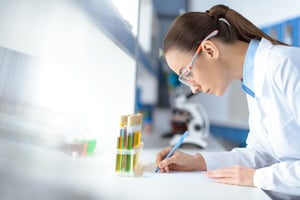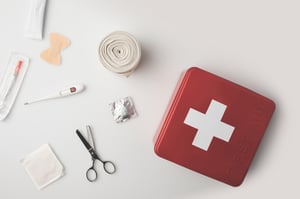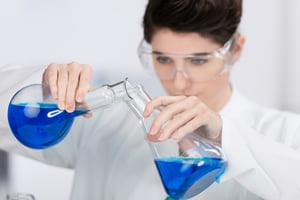In the bustling world of scientific exploration, where discoveries are made, breakthroughs are achieved and boundaries are pushed, there exists an unsung hero that often goes unnoticed … the ensemble of lab safety supplies.
These silent guardians, ranging from protective coats to emergency equipment, stand as the steadfast protectors of both scientists and the integrity of their experiments.
If something goes wrong in your laboratory, it’s critical to have the right supplies on hand to ensure that not only your employees are safe, but that an emergency situation can be quickly controlled. After all, emergencies don’t make appointments, so it’s important to be ready should one unexpectedly occur.
While every workspace is different, here are some common lab safety supply essentials many labs should have available to workers right now.
Personal Protective Equipment
Personal protective equipment, or PPE, is found in almost every lab. However, it’s important to match the appropriate PPE with the hazards that are present in your lab.
appropriate PPE with the hazards that are present in your lab.
Some common types of PPE include:
- Clean room garments like lab coats, coveralls and full body suits
- Eye protection like lab safety glasses, lab safety goggles and face shields
- Gloves
- Protective hearing devices
- Hard hats
- Respirators
- Safety shoes and protectors
- Surgical face masks
- Fire extinguishers
Let’s dive into a few of these PPE pieces in more detail.
Lab Coats and Gowns
Lab garments aren't fashion statements. They’re essential protective barriers that guard against chemical splashes, biological contaminants and accidental spills. Lab coats and gowns act as the first line of defense, creating a physical barrier between the wearer and the substances they handle.
Selecting the appropriate lab coat or gown is crucial for ensuring maximum protection. Considerations like material, size and design play a vital role in their effectiveness. Lab coats and gowns should also be made of durable, flame-resistant fabrics that offer chemical resistance and provide coverage from neck to knee.
Look for options with long sleeves, snug cuffs and high collars to minimize the potential for exposure. Choosing the right fit is also important to allow freedom of movement while avoiding loose-fitting clothing that may pose a safety risk.
Eye Protection
Our eyes are incredibly delicate, and in the laboratory setting, they are constantly exposed to potential dangers like chemical splashes, flying particles or even intense light sources. Goggles and safety glasses are an absolute necessity to safeguard this vital sense organ.
Goggles should provide a secure, snug fit around the eyes, ensuring complete coverage and protection from all angles. They form a protective barrier that prevents chemicals or particles from reaching the eyes, reducing the risk of injury or damage.
Safety glasses are designed to shield against impact hazards, providing a protective shield for the front and sides of the eyes.
When selecting eye protection, ensure that the goggles or safety glasses meet the required safety standards for your specific lab environment. Look for options with anti-fog and scratch-resistant coatings to maintain clear vision and durability.
Hand Protection
Hands are highly susceptible to chemical exposures, cuts, burns and punctures in the laboratory. To safeguard against these risks, selecting the appropriate gloves is important.
When choosing gloves, consider the specific tasks and chemicals involved. Different glove materials offer varying levels of resistance to specific chemicals and hazards. Common glove materials include nitrile, latex, neoprene and vinyl.
Nitrile gloves, for instance, provide excellent chemical resistance and are suitable for many laboratory applications, whereas latex gloves offer good tactile sensitivity but may not be appropriate for individuals with latex allergies.
Proper glove selection also involves assessing the glove thickness, fit and length. Thicker gloves provide increased protection against chemical splashes, while a proper fit ensures dexterity and comfortable wear. Choosing gloves with an adequate length that extends over the wrists provides additional coverage and prevents accidental exposure.
Footwear
When it comes to safety in the lab, appropriate footwear can be easily overlooked. In many labs, simply wearing closed-toe shoes is enough to offer the right amount of protection. However, it’s important to consider other hazards in the lab as well, such as the risk of slips, trips and falls, making shoes with some tread on the bottom ideal as well.
Shoes worn in the lab should also be made of durable materials that can withstand exposure to chemicals, punctures and abrasions. Ill-fitting or uncomfortable shoes can also lead to distractions and potential accidents.
Some lab environments may require additional features in footwear, such as electrical hazard protection or static dissipative properties. Assess the specific hazards present in your lab and choose shoes that meet the necessary safety standards and regulations.
First Aid Supplies
Accidents happen, even in the most cautious laboratory settings. That’s why having a well-equipped basic first aid kit and first aid supplies readily available is essential. A basic first aid kit serves as a primary response system for addressing minor injuries and providing initial care until professional medical help can be accessed.
first aid kit and first aid supplies readily available is essential. A basic first aid kit serves as a primary response system for addressing minor injuries and providing initial care until professional medical help can be accessed.
A comprehensive basic first aid kit for the lab should include items such as:
- Adhesive bandages
- Sterile gauze pads
- Adhesive tape
- Antiseptic wipes
- Scissors
- Tweezers
- Disposable gloves
- CPR face shield
Regularly check and restock the first aid kit to ensure all items are available when needed. Familiarize yourself and your lab colleagues with the contents of the kit and basic first aid procedures to promote a quick and effective response to minor injuries as well.
Emergency Procedure Lists
In the event an emergency happens, it’s essential to have procedure lists readily available that helps workers know which actions to take. It’s critically important that these lists be placed in a visible location and that workers are trained to know these locations.
Examples of emergency procedure lists often found in labs include:
- Emergency eyewash procedures
- Emergency shower procedures
- First aid treatment for chemical burns
- Chemical spill response
- Fire emergency procedures
- Medical emergency procedures
- Power failure or equipment malfunction responses
- Natural disaster or hazardous weather safety information
- Evacuation procedures
- Managing gas leaks or odors
Conducting regular emergency drills can also help ensure quick and effective responses if one of the above situations occurs.
Chemical Storage And Handling
Although lab safety often focuses on tools that are on a smaller scale that are used to prevent hazardous work conditions or respond when emergencies occur, how a lab handles its chemical storage is another important consideration.
work conditions or respond when emergencies occur, how a lab handles its chemical storage is another important consideration.
Chemical storage cabinets are essential tools for organizing and safeguarding these materials. They can serve as the first line of defense against accidental spills, chemical reactions and potential exposure to harmful substances.
When choosing your lab cabinets, make sure you look at factors like ventilation and spill containment. Chemical storage cabinets should be well-ventilated to prevent the accumulation of hazardous vapors. Proper ventilation helps maintain air quality and reduces the risk of inhalation exposure. Cabinets with built-in ventilation systems or placement in well-ventilated areas are highly recommended.
Spill containment measures within the chemical storage cabinets can include spill trays or absorbent materials to contain and control spills, preventing them from spreading and causing further hazards.
Once you have your chemical storage cabinets in your workspace, ensure that you segregate chemicals based on their compatibility to prevent potential reactions, and clearly label all storage containers and shelves with lab safety symbols, chemical names and appropriate warning signs.
Organize chemicals in a way that allows for easy accessibility and retrieval, and place hazardous materials at lower levels to help prevent accidents when reaching for them.
Safety Data Sheets
Safety Data Sheets (SDS), formerly known as Material Safety Data Sheets (MSDS), are crucial components of lab safety. They provide vital information about the hazards, safe handling, storage and emergency procedures associated with each chemical.
While chemical labels contain some essential details like hazard symbols and precautionary statements, Safety Data Sheets (SDS) provide more comprehensive information about a chemical’s properties, hazards, safe handling procedures and emergency response.
They also include details like:
- Physical and chemical properties
- Exposure limits
- Storage requirements
- Disposal considerations
SDSs should be readily accessible to all personnel working with the chemical and should be reviewed before using or handling the substance.
Lab Safety Supply Checklist
Now that you have a better idea of the supplies you should have on hand to ensure lab safety, it’s time to check your workspace to make sure you have all of the essentials.
For more ideas on lab safety supply essentials you should have in your lab, check out our Lab Safety Supplies Checklist.


